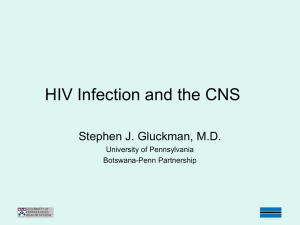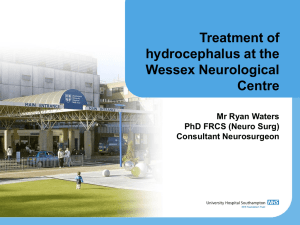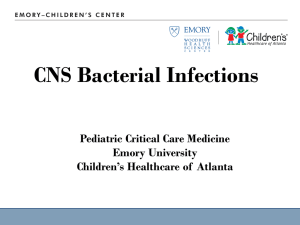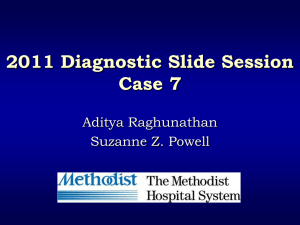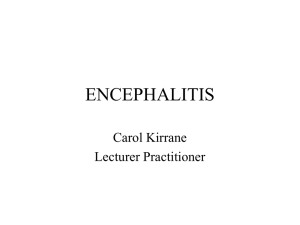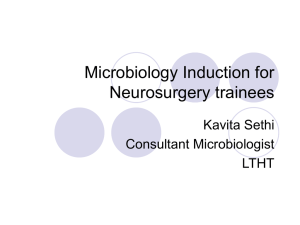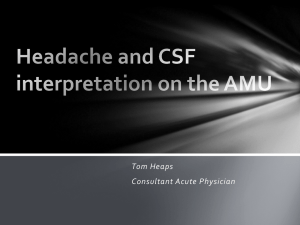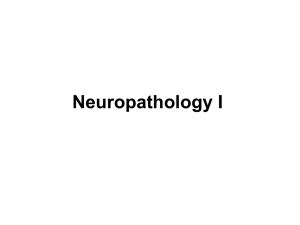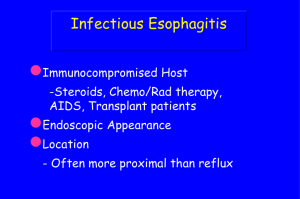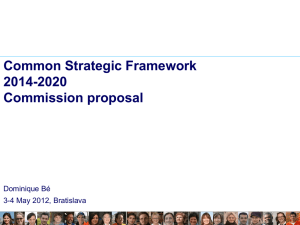CNS Other Infections - Emory University Department of Pediatrics
advertisement
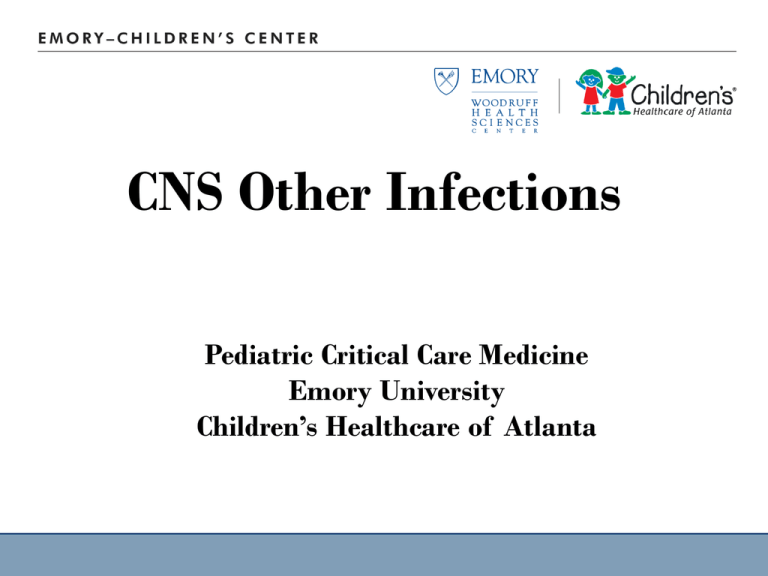
CNS Other Infections Pediatric Critical Care Medicine Emory University Children’s Healthcare of Atlanta ASEPTIC MENINGITIS Viral, atypical bacteria, fungal, TB Etiologies: Viruses and Bacteria - Adenovirus - Arbovirus - Enteroviruses - Herpesviruses - HIV - Influenza A/B - Japanese encephalitis - Measles - Mumps - Rubella - Rabies - Lymphocytic choriomeningitic virus - Bartonella henslae - Bordetella pertussis - Borrelia burgdorferi - Brucella spp. - Chlamydia spp. - Ehrlichia, Leptospria spp. - Mycobacteria spp. - Mycoplasma spp. - Rickettsia spp. - Treponema pallidum Etiologies: Fungal and Others • • • • • • Aspergillus fumigatus Blastomyces dermatitidis Candida spp. Crytococcus neoformans Coccidioides immitis Histoplasma capsulatum • • • • • Toxoplasma gondii Entamoeba histolytica Acanthamoeba Trichinella Naegleria TB Meningitis • Most serious complication of TB infection • Fatal without effective treatment, significant morbidity even with treatment • In children CNS involvement occurs during primary infection (rather than reactivation) • Usually results from hematogenous spread from a primary focus (lungs) • Variable presentation, but usually onset is insidious – More rapid in infants and young children TB Meningitis Clinical Staging Stage Signs and Symptoms Stage 1 (Early) Days to weeks Fever, HA, malaise Lethargy, behavior changes No neuro deficits No alteration of consciousness Stage 2 (intermediate) Weeks to months Meningeal irritation Minor neuro deficits (CN) Stage 3 (late) Months to years Abnormal movements Convulsions Stupor or coma Severe neuro deficits Diagnosis * Isolation or identification of mycobacterium is the gold standard for diagnosis Possible in about 80% of cases PCR, ADA, ELISA have varying degrees of accuracy * Typically 10-500 WBCs, with predominance of lymphs * CSF glucose <40, protein moderately elevated (150-200) * CSF can be normal in children with unruptured tuberculomas * Neuroimaging will be very helpful * Look for the primary TB site Treatment • Typically requires at least 3 or 4 drug therapy – Isoniazid, rifampin, pyrazinamide +/- ethambutol or streptomycin • WHO recommends at least a 4 month course for TB meningitis • Steroids have been shown to significantly reduce the neurologic sequelae of TBM • They often require a shunt for hydrocephalus • Prognosis varies – but depends on clinical stage at the time treatment is started ENCEPHALITIS AND MYELITIS Encephalitis * Refers to inflammation of the brain parenchyma * Pathology shows: Inflammation and destruction of neurons Pathogen detection by direct visualization, staining, etc * Referred to as postinfectious encephalitis when in temporal association with viral infection or immunization ADEM when it includes spinal cord * Can cause significant alterations in sensorium and seizures Many patients require ICU Etiology * In neonates, the most common etiology is HSV (usually type 2), but also entero- and adenovirus * In older children arthropod-borne viruses (arboviruses) and enteroviruses are the most common Arbo: EEE, WEE, St. Louis, West Nile, JE Entero: polio, echo, coxsackie, etc * Subacute sclerosing panencephalitis is a now rare complication of measles infection * Tick borne bacteria can also be implicated Borrelia, Rickettsia, ehrlichiosis Pathogenesis * Once a virus crosses the epithelium (usually at a mucosal surface) viral replication occurs, followed by viremia * Viruses can penetrate the CSF from the blood, or by spread from peripheral neurons (rabies and HSV) * Once in the CNS the virus attaches to host cells Viral genome replication takes over, affecting the other functions of the cell * Interferon in particular inhibits viral penetration, replication, translation, and assembly The inflammatory process may turn on the host Clinical Manifestations * Varies depending on affected site, severity, and host factors May or may not involve meninges (rabies) * Nonspecific symptoms in neonates May not have maternal h/o HSV * Older children have acute onset of fever, HA, seizures, behavior changes, AMS, or coma, +/- prodrome Depends on site of involvement May have paralysis or paraplegia if spinal cord involved Look for rashes (erythema migrans) Diagnosis * CSF findings are non-specific Cells and protein may be normal or slightly elevated May see predominance of lymphs * May get a diagnosis from culture, antigen detection, PCR, or antibody titers PCR stays positive for months, highly sensitive and specific * EEG can help distinguish focal from generalized encephalitis HSV has characteristic periodic lateralized epileptiform discharges (PLEDs) Neuroimaging Etiology Site of involvement on MRI HSV Inferomedial temporal and frontal lobes Japanese encephalitis Bilateral thalami and basal ganglia Rabies Hippocampal, cerebellar, mesencephalic areas Eastern equine encephalitis Disseminated brain stem and basal ganglia Management * Children with suspected encephalitis warrant ICU monitoring * Antimicrobial therapy is appropriate until bacterial meningitis has been ruled out * Antiviral therapy should be started when appropriate: HSV – acyclovir CMV – ganciclovir or foscarnet Flu A/B – amantadine/rimantadine (A only), oseltamivir (A and B) No specific therapy for entero- and arboviruses Consider IVIG in immune compromised patients HSV Encephalitis • HSV is the most common cause of fatal encephalitis in childhood – Mostly HSV-1 after neonatal period • Encephalitis can result from both primary and recurrent HSV infection – Primary CNS if via olfactory and trigeminal nerves • Disseminated HSV in the neonate affects the CNS by hematogenous spread HSV: Clinical Presentation Neonatal Older children • Skin vesicles, scarring • Eye involvement (chorioretinitis, optic atrophy) • Brain (microcephaly, encephalomalacia) • Disseminated disease (sepsis, ARDS, MODS) • Older children have typical symptoms of encephalitis • Behavior, personality, and speech changes are particular to HSV • Progression may still be rapid and fatal in nonneonates Diagnosis * Swabs from conjunctiva, nasopharynx, rectum, skin lesions * MRI may show temporal or frontal involvement * PLEDs on EEG * HSV PCR is 95 % sensitive and 100% specific (gold standard) * Please don’t do a brain biopsy HSV: Treatment and Prognosis • ACYCLOVIR – 20 mg/kg q8h for 14-21 days in neonates – 10 mg/kg q8h in older children • Need a negative CSF PCR before stopping therapy • Steroids have not been proven in children • Early treatment reduces morbidity and mortality • Relapse occurs in 12% of adult patients • Disseminated neonatal disease has 50% mortality and 50% of survivors have significant sequelae ADEM Acute Disseminated Encephalomyelitis ADEM: Introduction • ADEM is an inflammatory demyelinating disorder of the CNS • Mostly seen in children and young adults • Can be multiphasic (must distinguish from MS) • Often preceeded by respiratory or GI viral illness • Has also been reported after immunizations – MMR and rabies vaccines ADEM: Clinical Presentation * Mean age of presentation is 7 years, slightly > males * Fever, HA – rapidly progresses to AMS and multifocal neuro deficits Evolution may occur over a few days * Deficits depend on affected areas White matter, spinal cord, optic nerves Ataxia and extrapyramidal symptoms are common UMN signs in affected limbs * Fulminant presentation with rapid deterioration is rare, but usually occurs in children < 3 yrs ADEM: Diagnosis • The Brighton collaboration has published a very complicated clinical definition of ADEM – Based on varying levels of diagnostic certainty – histopathology, imaging, presentation, etc • CSF is not helpful in making a diagnosis of ADEM – May show pleocytosis or be normal – 10% of cases have oligoclonal bands – Myelin basic protein may be increased • EEG may show focal or generalized slowing Neuroimaging ADEM: Treatment • Mainstay of treatment is methylprednisolone 20-30 mg/kg/day for 3-5 days – Taper over 3-6 weeks • Plasmapheresis and IVIG have also been used – Considered when meningoencephalitis cannot be excluded – Concern that steroids would worsen possible infection – Combing either of these with steroids show no added benefit ADEM: Prognosis • Most children with mild to moderate illness and appropriate treatment achieve good recovery – Acute mortality is rare – Fulminant cases are at higher risk of mortality • 1/3 of cases have residual deficits – Motor, visual, autonomic, developmental, epilepsy • Relapses may occur during the steroid taper – Recurrent attacks can occur after full recovery BRAIN AND SPINAL CORD ABSCESS Brain and Spinal Cord Abscess • May occur as a primary infection or as a complication of bacterial meningitis (more rare) • Rogers says that intensivists like them because they are a serious, potentially fatal infection that requires immediate intervention Abscesses: Etiologies * Most common pathogens include anaerobes, GN’s, streptococci, and staph * Neonates most commonly get GN’s: Citrobacter, Enterobacter, Proteus * In other populations the organism depends on predisposing factors: CHD – a-hemolytic strep Endocarditis – strep, S. aureus Post-trauma – staph Otitis/sinusitis – strep, Bacteroides fragilis, Proteus spp., pseudomonas, H.flu Abscesses: Pathogenesis * May occur via hematogenous or direct spread * Cyanotic heart disease is the most common underlying condition (esp. TOF) Polycythemia higher viscosity microinfarcts Bacteria love it! * Chronic pulm infection, bacterial endocarditis, and immune compromise also increase risk * Direct spread may occur from chronic otitis, mastoiditis, sinusitis, trauma, NS procedures * Meningitis is a rare cause if treated appropriately Except in neonates with GN meningitis Abscesses: Pathogenesis * Bugs localize at the gray-white junction cerebritis * Stage 1: Early cerebritis (Day 1-3) Leukocyte infiltration, focal edema, no clear demarcation * Stage 2: Late cerebritis (Day 4-9) Central liquefaction necrosis (yum!), fibroblast infiltration, capsule formation * Stage 3: Continued capsule formation * Stage 4: Late capsule formation (2 weeks out) Dense fibrous capsule, marked edema Abscesses: Pathogenesis • • • • • Entire process may take 4-6 weeks May progress faster or rupture into ventricular system Sites of infection vary but cerebral are most common Kids with CHD get them in MCA distribution Otitis can spread to unilateral temporal lobe or cerebellum Abscesses: Diagnosis • LP would be contraindicated in a patient with brain or spinal cord abscess – But…CSF may show pleocytosis, ↑ protein, normal glc • Blood cultures and cultures from other potential foci would help • Get imaging Abscesses: Imaging Abscesses: Imaging Abscesses: Treatment • Surgical drainage or excision is required in many cases – Usually under CT guidance • Smaller abscesses may be manageable with antibiotics alone • Empiric therapy is usually a 3rd/4th gen cephalosporin + metronidazole – Add vanc if staph is suspected – Tailor therapy once an organism is defined – IV therapy for at least 6 weeks Abscesses: Prognosis • Mortality is high in several groups: – Newborns, young infants – Children with multiple large abscesses and CHD – Intramedullary abscess of spinal cord (vs. subdural or epidural spinal abscesses) • Rupture of an abscess can be life-threatening • Residual defects are common – Hemiparesis, CN palsies, cognitive defects, epilepsy • Early decompression improves outcome Cerebritis Vasculitis Shunt Infections • 2/3 of all shunt infections are caused by staph spp – Staph epi, aureus, and other coag-negative types have been frequently isolated in several series • GN enterics (E.coli, Klebsiella, Proteus, Pseudomonas) make up 6-20% • Strep causes 8-10% • Multiple organisms are found in 10-15% • Incidence has declined over the past few years – 70-85% of infections are within 6 months of surgery Pathogenesis * Shunts are foreign bodies and interfere with natural host defense mechanisms Chemotaxis and phagocytosis * Staph can also form biofilm which increases bacterial adherence and decreases effect of antibiotics * Infection may occur through different mechanisms: Wound or skin breakdown over shunt Colonization at the time of surgery Retrograde from the distal end of shunt Hematogenous seeding (infrequent) Clinical Presentation • Fever, headache, vomiting, lethargy, altered mental status • Check for wounds and look for cellulitis along the shunt • Infection may spread to the distal end of the shunt and cause peritonitis Diagnosis • Isolation of organisms from CSF or equipment – Other CSF studies are variable • If there is associated shunt malfunction there may be an increase in ventricular size on CT • Distal shunt infections can also cause abdominal pseudocysts Treatment • Antibiotics are a mainstay of treatment – Some propose shunt removal or externalization only if there is no response to antibiotics • Associated ventriculitis may clear more quickly with externalization • Cover staph with cloxacillin or vanc + an aminoglycoside – Rifampin is often added • Intraventricular therapy is sometimes indicated CNS FUNGAL INFECTIONS Aspergillus, Cryptococcus CNS Fungal Infections Predisposing Condition Fungal Pathogen Prematurity Candida albicans Primary immunodeficiency (CGD, SCID) Candida, Cryptococcus, Aspergillus Corticosteroids Cryptococcus, Candida Cytotoxic agents Aspergillus, Candida Secondary immunodeficiency (AIDS) Cryptococcus, Histoplasma Iron chelator therapy Zygomycetes IV drug abuse Candida, Zygomycetes Ketoacidosis, renal acidosis Zygomycetes (Mucor) Trauma, foreign body Candida CNS Fungal Infections • Don’t forget about the fungi that can cause disease in a healthy host: – Cryptococcus, Histoplasma, Blastomyces, Coccidioides, Sporothrix • Fungal infections are on the rise worldwide due to increasing prevalence of HIV Fungal Meningitis • Most common causes are Cryptococcus neoformans, C. immitis, Candida, and Aspergillus • Fungal meningitis in general has a more insidious onset than bacterial – Symptoms may develop over days – Always consider it with subacute/chronic presentation • C.neoformans may develop more quickly in patients on highdose steroids or with HIV Fungal Meningitis • Rhinocerebral syndrome is a major presentation of zygomycosis – Rhizopus and Mucor spp – Associated with poorly controlled DM – Orbital pain, nasal discharge, facial edema, proptosis • May invade carotids, trigeminal nerve and adjacent brain structures – May also present with sudden neuro deficit due to vasculitis – Can rarely cause mycotic aneurysmal bleed Diagnosis * Have a low index of suspicion in immune compromised patients with fever and CNS signs * CSF usually has high protein, low glucose, and 20-500 WBC’s Cell count may be LOW (<20) with AIDS or high dose steroids * India ink prep can identify >50% of C.neoformans cases (up to 80% in AIDS) Diagnosis - Cultures are frequently negative Candida takes days to grow, histo/coccidio take weeks - Methenamine stain of an aspirate or biopsy can help identify Aspergillus and Zygomycetes, which can cause tissue invasion and necrosis Treatment Fungus Initial Regimen Second Regimen Other Considerations Candida Amphotericin B + flucytosine x 2 wks Fluconazole x 8-10 weeks Remove shunt if appicable. Cryptococcus Ampho B + flucytosine x 2 wks Fluconazole x 8-10 weeks Repeat LP after 2wks of ampho. Stop steroids. Coccidio Ampho x 4wks Fluconazole or ampho 4eva Serial monitoring of CSF Aspergillus High dose ampho + excision PO vori or ampho x 1 yr Excision is key. Prognosis • Depends on underlying disease process – Why are they immune suppressed? • Candida meningitis has a mortality of 10-20% • Only 50% of patients with coccidioidal meningitis survive initial treatment – Survivors have a high risk of relapse • A cryptococcal vaccine has been developed, not sure if it is available yet PARASITIC CNS INFECTIONS Neurocysticercosis and Cerebral Malaria Neurocysticercosis - Most common parasitic CNS infection. Important cause of epilepsy in the tropics. - Most cases present with seizures. 1/3 present with raised ICP. - Endemic in Latin America, Mexico, India, sub-Saharan Africa, and China. Including developed countries. >1000 new cases are diagnosed in the US each year. Taenia solium Life Cycle Neurocysticercosis Parenchymal Extraparenchymal • Seizures in 70-90% of patients • 1/3 will have raised ICP • 4% have focal neuro deficits • May have encephalitis • Rare in children • Obstructive hyrdocephalous or chronic meningitis • Spinal involvement – Numerous cysts – Diffuse cerebral edema – Poor prognosis – Radicular pain – Cord compression – Transverse myelitis • Ophthalmic involvement – Vision deficits Neurocysticercosis Treatment - Praziquantel and albendazole are both effective - But albendazole is better tolerated and penetrates CSF better. 15 mg/kg/day x 28 days - There are some times to NOT use cysticidal therapy: Markedly raised ICP – inflammatory response will be bad, give only steroids Ophthalmic NCC Calcified lesions – parasite is already dead - Use steroids to reduce cerebral edema or if there is encephalitis - Repeat CT in 3-6 months to assess lesions CEREBRAL MALARIA Last one! Cerebral Malaria • Clinical syndrome characterized by CNS dysfunction associated with Plasmodium falciparum infection • Becoming more common in developed countries due to increases in international travel and migration • Pathophysiology is different in children who grew up in endemic areas vs. those who are non-immune Etiology • P. falciparum causes almost all life-threatening malaria. – Transmitted by anopheline mosquitos • Sporozoites enter the bloodstream and visit the liver before invading erythrocytes • Trophozoites and schizonts are sequestered in the microcirculation of vital organs – Obstructs blood flow and impairs function of parenchymal cells – That’s bad Epidemiology • Endemic in tropical areas – Southeast Asia, Central/South America, Africa • 300-500 million cases and 1.5-3 million deaths annually – One of the top 3 infectious disease killers worldwide Pathogenesis - Plasmodial infections stimulate monocyte release of cytokines (TNF, IL-1, IL-6) - Pathogenesis of cerebral malaria is not well understood Likely multi-factorial mechanisms of neuro dysfunction May be due to obstruction of microvasculature Increased CSF lactate production - Global ischemia doesn’t seem occur - Pathologic hallmark is engorgement of cerebral capillaries with infected erythrocytes Clinical Presentation - Suspect it in any child who has visited (or even landed in an airport!) an endemic area and develops CNS symptoms. - Fever, HA, irritability, altered mental status. - Seizures are common. - Retinopathy (including hemorrhages) - Metabolic acidosis - Hypoglycemia (associated with poor prognosis) In non-immune adults it is from hyperinsulinemia In African children it is impaired gluconeogenesis. -Hemolytic anemia, may be severe. Diagnosis • CSF is usually acellular – consider other diagnosis if there is pleocytosis • Protein and glucose are normal, CSF lactate is up • Associated with GN sepsis • Parasite count ranges from barely detectable to >20% – May not be detectable at first – Need blood smears q6h x 48hrs to rule out Treatment - Children with severe malaria need parenteral therapy: Cinchona alkaloids (quinine, quinidine) Artermisinin compounds (not available in N. America) - Side effects include cinchonism, but serious CV effects may occur if drugs are given undiluted or too fast Hypotension, arrythmias Watch QT during infusion - Supportive care is important, many children die in the first 24 hours. - Watch glucose, fluid balance, renal function, HCT. - Exchange transfusion may be indicated for parasitemia >10% or if not responding to therapy. - Steroids appear to increase bleeding and offer no benefit. Prognosis • Mortality in non-immune patients is 15-26% • Many patients die in the first 4 days from renal failure or pulmonary edema • African children have similar mortality but they die in the first 24 hours – Often from herniation, severe hypoglycemia, anemia • Survivors have significant neurologic sequelae Prevention • No vaccine is available for malaria. • Prophylaxis is recommended for travelers. – Mefloquine or atovaqone-proguanil. • Protection from mosquito bites is also important. – Repellant, netting, protective clothing.
